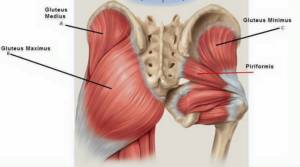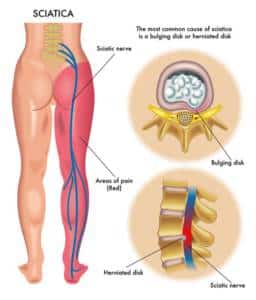What is Sciatica Pain and Piriformis Syndrome
A lot of the times the Sciatica Pain gets confused with Piriformis Syndrome. Sometimes not only the people who suffer can’t tell what it is but as well doctors, massage therapists, physical therapists, chiropractors and other prod can get a little confused. Here is some pointers to know better what actually you might be experiencing- if you have pain in your lower back, glutes and/or your hamstrings.
Real Sciatica Pain is caused by Sciatica nerve being pinched but the spine- slipped or herniated disk usually in the lower back. Real Sciatica now also can be fixed with quick laser surgery, PT and more. And Piriformis Syndrome is when sciatic nerve gets pressed by tight Pirifomis Muscle which is located under the Glute muscles. It kind of extends from your hip socket to the sacrum.

Piriformis Muscle Illustration

Sciatica Nerve Pain Caused By Spine Pinching the Nerve
Sciatica usually affects only one side of the lower body. Often, the pain extends from the lower back all the way through the back of the thigh and down through the leg. Depending on where the sciatic nerve is affected, the pain may also extend to the foot or toes.
How to tell “False-sciatica” from regular Sciatica
Simple Real Sciatica Test
Start while sitting on the edge of a table or counter top with your legs hanging off. Straighten the leg that is having the discomfort. Keep your toes pointing up. When your leg is stretched out and parallel to the floor and your symptoms increase in intensity, there is a good chance you are dealing with some kind of herniated disc/nerve issue.
If straightening the leg does not increase symptoms, there is a good chance your pain could be caused by an over-active piriformis muscle.
Testing for Piriformis Syndrome aka False Sciatica:
While in the seated position, take the affected knee up towards the same shoulder. Then slowly move the knee across your lap and over towards the opposite shoulder. If the pain increases as you make this transition, you should spend some time working on releasing your Piriformis.
Sometimes a person might have both conditions at the same time. In that case both of them need to be treated with best methods for each as determined by a professionals you are seeing.
-Jolita Brilliant, LMT in Burlington, Vermont


